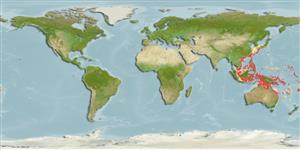>
Eupercaria/misc (Various families in series Eupercaria) >
Labridae (Wrasses) > Bodianinae
Etymology: Bodianus: Bodianus after Bodiano or Pudiano, from the Portuguese pudor, meaning modesty (Jordan & Evermann, 1896).; izuensis: Named for its type locality, the Izu Peninsula and Izu Oceanic Park, Shizuoka Prefecture, Japan (Ref. 75973).
Environment: milieu / climate zone / depth range / distribution range
Écologie
marin récifal; profondeur 30 - 70 m (Ref. 90102), usually 30 - 35 m (Ref. 75973). Subtropical
Western Pacific: Japan, Australia and New Caledonia (Ref. 75973); also Taiwan (Ref. 12711) and Palau (Ref. 31061).
Taille / Poids / Âge
Maturity: Lm ? range ? - ? cm
Max length : 10.0 cm SL mâle / non sexé; (Ref. 43239)
Épines dorsales (Total): 12; Rayons mous dorsaux (Total): 9-10; Épines anales 3; Rayons mous anaux: 12. This species is distinguished by the following characters: D XII,9-10; caudal-fin rays 9-10 + 2 + 10; pectoral-fin rays ii, 14-15; 30 lateral-line scales; 4-4.5 scales above lateral line; 10.5-12 scales below lateral line; about 8-10 predorsal scales; 14-18 total gill rakers; moderate depth in body and caudal peduncle; short snout; scaly basal sheath on dorsal and anal fins ½–2 scales in depth; posterior corner of mouth
just posterior to vertical through forward extent of orbit; upper jaw with the first prominent anterior canine slightly smaller than second; moderately developed canines on dental ridge in small individuals 2-10, less distinct in larger
specimens; prominent canines at posterior
end of jaw 1–2 (usually 2); lower jaw with first prominent anterior canine slightly more than half size of second; teeth in 2 or 3 series on dental ridge, forming single row; first series with 3–9
small canines becoming progressively longer posteriorly, originating immediately posterior to anterior canines; first series followed by 4–10 short canines in series, sometimes 2 slightly larger canines terminally; vomer 1 or 2 canines; pelvic fin distinctly not reaching anus (Ref. 75973).
Adults occur on deep rocky reefs (Ref. 75973). Oviparous, distinct pairing during breeding (Ref. 205).
Life cycle and mating behavior
Maturité | Reproduction | Frai | Œufs | Fécondité | Larves
Oviparous, distinct pairing during breeding (Ref. 205).
Gomon, M.F., 2006. A revision of the labrid fish genus Bodianus with descriptions of eight new species. Rec. Aust. Mus. Suppl. 30:1-133. (Ref. 75973)
Statut dans la liste rouge de l'IUCN (Ref. 130435)
Menace pour l'homme
Harmless
Utilisations par l'homme
Aquarium: Commercial
Plus d'informations
RéférencesAquacultureProfil d'aquacultureSouchesGénétiqueElectrophoresesHéritabilitéPathologiesTraitementNutrientsMass conversion
Outils
Articles particuliers
Télécharger en XML
Sources Internet
Estimates based on models
Preferred temperature (Ref.
123201): 24.2 - 28.5, mean 27.4 °C (based on 25 cells).
Phylogenetic diversity index (Ref.
82804): PD
50 = 0.5000 [Uniqueness, from 0.5 = low to 2.0 = high].
Bayesian length-weight: a=0.01202 (0.00551 - 0.02625), b=3.05 (2.87 - 3.23), in cm total length, based on LWR estimates for this Genus-body shape (Ref.
93245).
Niveau trophique (Ref.
69278): 3.4 ±0.44 se; based on food items.
Résilience (Ref.
120179): Haut, temps minimum de doublement de population inférieur à 15 mois (Preliminary K or Fecundity.).
Fishing Vulnerability (Ref.
59153): Low vulnerability (10 of 100).
